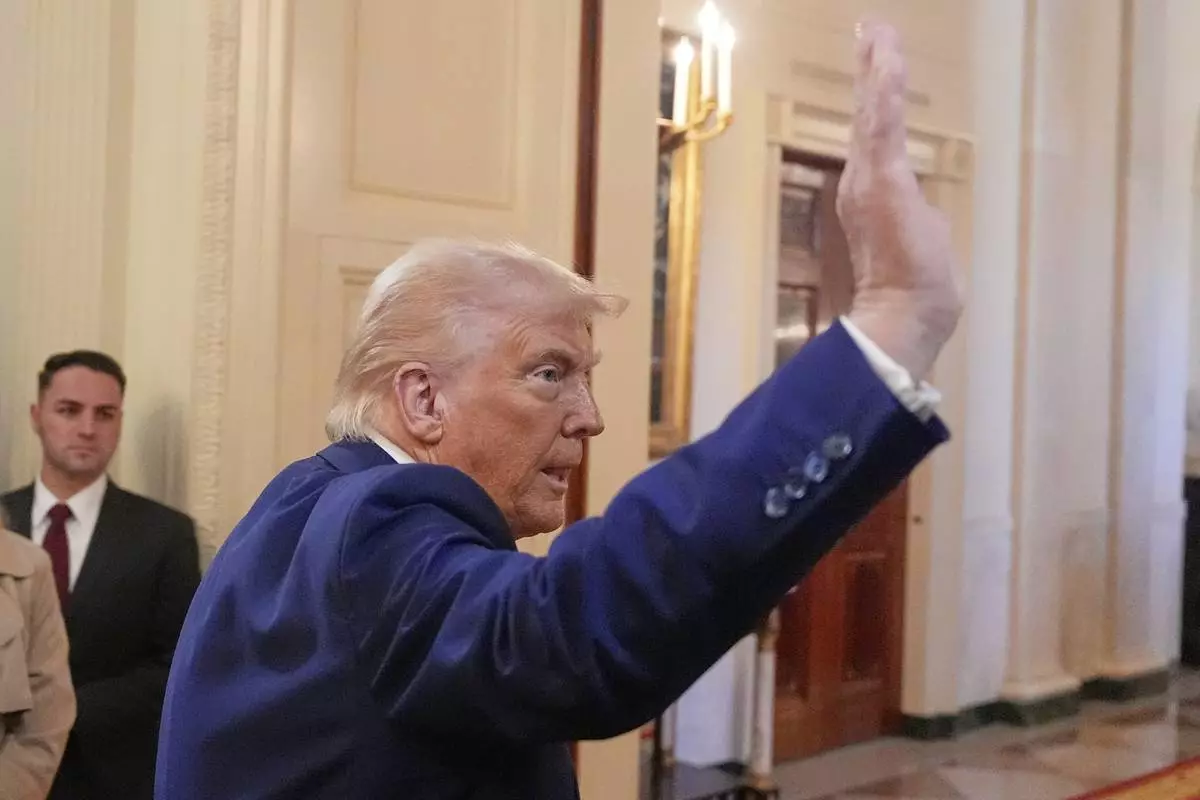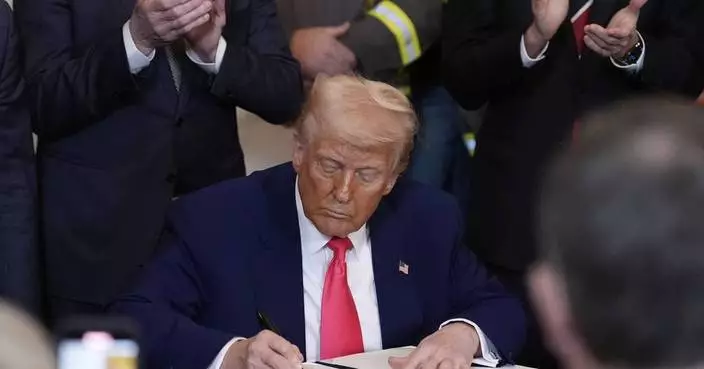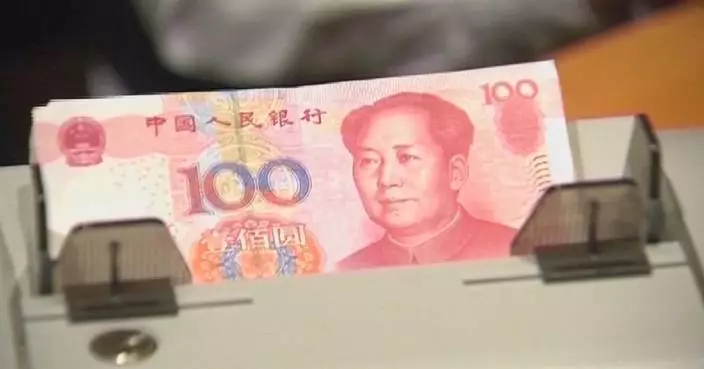BOSTON (AP) — EDITOR’S NOTE — This story includes discussion of suicide. If you or someone you know needs help, the national suicide and crisis lifeline in the U.S. is available by calling or texting 988. There is also an online chat at 988lifeline.org.
Red Sox outfielder Jarren Duran said in an upcoming documentary series that two years before his 2024 All-Star season, the pressures of the sport led him to intense bouts of depression and an attempted suicide.
“I remember when I was going through it and you start losing a couple of games and you’re not doing good, it feels like the world is kind of creeping in on you," Duran, 28, said in the fourth episode of an eight-part Netflix series titled, “The Clubhouse: A Year With the Red Sox,” which will debut on Tuesday.
The episode chronicles the journey of Duran, a seventh-round draft pick in 2018, to making his MLB debut in 2021 after becoming one of the majors' top prospects as one of the top hitters in the minors. It also delves into his struggles not long after getting called up to the majors, as the former infielder had a difficult time adapting to playing in the outfield.
“They love you one day, and then the next day they have to grind on you a little bit," Duran recalled.
He said there were times he felt players were treated like “zoo animals.”
“Sometimes some fans take it too serious. I feel they cross the line when they start talking about my mental health — making fun of me for that," Duran said. "Calling me weak. It just kind of triggered me when you start talking about mental health because I feel like that is just part of it — that loneliness. Some people deal with it better than others."
The intense atmosphere of the Boston sports media market also wore on him, he said.
“I remember when I first started struggling I was like, just send me back down (to the minor leagues)," he recalled. "It honestly felt like there was a dark cloud over me because it’s so easy to look past the positive things for me, and then to grab onto the negative things.”
That pressure to perform came to a head at one point for the young slugger.
“I couldn’t deal with telling myself how much I sucked everyday,” Duran said. “I was already hearing it from fans. And what they said to me, (it’s not like) I haven’t told myself 10 times worse in the mirror. That was a really tough time for me. I didn’t even want to be here anymore."
The series' director, Greg Whiteley, then asked, “When you say, ‘here,’ you mean here with the Red Sox or here on planet Earth?”
“Probably both,” Duran said before going into detail.
In a statement, Red Sox President and CEO Sam Kennedy commended Duran for being open about taking care of his mental health.
“Jarren’s decision to share his story is an act of courage that reaches far beyond baseball," Kennedy said. "By opening up, he’s showing others who may be struggling that they’re not alone and that asking for help isn’t just okay, it’s essential. Every member of this organization continues to stand with him. He has our deepest admiration, he’s always had our full support, and we’re incredibly fortunate to have him as part of our team.”
Manager Alex Cora said he was aware of the situation long before the Netflix filming.
“I mean, obviously, I was aware of it," Cora said on Monday before Boston's scheduled game against Toronto. "Since I learned about it, me as a person, I've been giving him support, love. I'm somebody that he can talk to. That door’s always open. The relationship has grown throughout the years. Obviously, a lot of private conversations about the subject. I truly believe that him opening up is going to help a lot of people.
“It takes a person with courage and being transparent and genuine to do that. ... I hope that’s how we see it — that he will impact others and he’s going to save lives with what he did in Netflix."
AP freelancer Ken Powtak contributed to this report.
AP MLB: https://apnews.com/hub/mlb

Boston Red Sox left fielder Jarren Duran makes a catch on a fly ball by Baltimore Orioles' Gary Sanchez for an out during the seventh inning of a baseball game, Wednesday, April 2, 2025, in Baltimore. (AP Photo/Nick Wass)

Boston Red Sox outfielder Jarren Duran lines out during the seventh inning of a baseball game against the Baltimore Orioles, Thursday, April 3, 2025, in Baltimore. (AP Photo/Daniel Kucin Jr.)
WASHINGTON (AP) — In the aftermath of this week's tariff whiplash, President Donald Trump is deciding exactly what he wants out of trade talks with as many as 75 nations in the coming weeks.
Trump is also figuring out next steps with China. He upped his tariffs on Chinese goods to 145% after China placed retaliatory taxes of 84% on imports from the U.S. While his 90-day pause on other tariffs caused the stock market to rally on Wednesday, countries still face a baseline 10% import tax instead of the higher rates announced on April 2.
Kevin Hassett, director of the White House National Economic Council, told Fox News’ “Fox and Friends" on Wednesday that the administration already has “offers on the table from more than 15 countries.”
Hassett said the next step will be determining exactly what Trump wants out of the negotiations.
“We have a meeting today with all the top principals where we’re going to present to the president a list of what we think his priorities might look like," Hassett said. "And I’m sure he’s going to, you know, have his own ideas about where to move things.”
Here's a look at where Trump's tariffs showdown stands:
With $28.9 trillion in publicly held debt, the U.S. government can still be beholden to the investors who lend it money. Trump might be willing to run roughshod over political rivals, judges he dislikes and a host of political norms, but the bond market showed Wednesday that it can temper his plans.
Going into Wednesday, the interest rate on a 10-year U.S. Treasury note was increasing and approaching 4.5%. That meant the U.S. government was having a tough time finding possible buyers for its debt, as market participants were wondering if Trump's tariffs had caused foreign buyers to sour on the U.S. government. Higher interest rates for the government could trigger even higher mortgage rates and auto loans for consumers, among other problems.
Trump on Wednesday said investors were getting “yippy,” but after his tariff pause he described the bond market as “beautiful.”
The S&P 500 stock index jumped 9.5% after the pause was announced. But reality crept back in on Thursday and the stock market slumped. Sure, Trump was no longer going to put a 20% tariff on goods from the European Union, a 24% tariff on Japan or 25% on South Korea. But those nations still have imports taxed at an elevated 10%, Trump's new baseline as trade talks begin. And tariffs went up against China, locking the world's two largest economies in a trade war.
Plus, the trade war has expanded with China, and 25% tariffs still apply to imported autos, steel and aluminum. Imports from Canada and Mexico, the two largest U.S. trading partners, still face import taxes of as much as 25%. And Trump still plans tariffs on pharmaceutical drugs, lumber, copper and computer chips.
“While we appreciate the pause, the reciprocal tariff of 10% still represents more than double the tariff on imports of leather footwear from countries like Vietnam and Cambodia,” said Tom Florsheim, CEO of the Weyco Group, a footwear company. “Even at this level, it means a significant cost increase that will impact consumers.”
Because tariffs are taxes paid by importers, the costs generally get passed along to consumers and businesses in the form of higher prices and slower economic growth. The Budget Lab at Yale University estimated on Thursday that even with the pause, Trump's current tariff regime would pull down a household's average disposable income by $4,364.
Treasury Secretary Scott Bessent said that any trade agreements will be “bespoke” deals, rather than some overarching pact among a group of countries. Trump has laid out a series of grievances and goals regarding tariffs, but Canadian and European counterparts have said the actual asks from administration officials have been vague so far.
Trump has said he wants to eliminate the $1.2 trillion trade deficit, which means he no longer wants the U.S. to import more goods than it exports to other nations. He also wants revenues from tariffs to offset his income tax cut plans. The president has also said he wants the tariffs to bring back factory jobs and raise workers’ wages.
Aides have said that Trump wants other nations to scrap regulations and other policies such as Europe's value-added taxes that he deems to be a barrier to U.S. goods, an ask that would require other countries to change their laws. Commerce Secretary Howard Lutnick has said the goal is to get other nations to “respect” Trump.
His goals might not necessarily be in line with what other nations want.
European Commission President Ursula von der Leyen posted on X that she's “consistently advocated for a zero-for-zero tariff agreement between the European Union and the United States.”
Lori Wallach, director of the Rethink Trade program at the American Economic Liberties Project, said Trump needs to be more publicly forthright about what he wants out of trade talks and tariffs.
“Absent transparency about what is being demanded, we could end up with the worst of all outcomes — a bunch of bad special interest deals, all of the economic damage caused by tariff uncertainty and no trade rebalancing, US manufacturing capacity or goods jobs,” she said.
The Trump administration views China as violating basic trade norms with how it subsidizes its manufacturers, takes intellectual property from its global competitors, suppresses wages for its workers and manipulates its currency.
The White House clarified that the 125% tariffs that Trump announced on Wednesday against China were actually 145%, once his previous 20% fentanyl tariffs were included.
Census Bureau data show the U.S. ran a $295 billion trade deficit last year with China. Because U.S. consumers and businesses are such a major customer of Chinese manufacturers, Bessent has said that gives the U.S. an edge in terms of inflicting pain on that nation's economy through tariffs. Of course, China has also spent several years preparing for a trade war.
Wendong Zhang, an economist at Cornell University, said that the Chinese economy might suffer a steeper hit to its gross domestic product than the U.S., but it's “likely to stick to its guns” due to internal public support and the ability to increase consumption domestically on goods that might no longer be going to the U.S.
Meanwhile, Trump will need to deal with voters who might be frustrated over the higher price of electronics and other goods resulting from the trade wars.
“Many products that the U.S. imports are predominantly from China: smartphones (73%), laptops (78%), video game consoles (87%), toys (77%), and also antibiotics for U.S. livestock production," Zhang said in an email. “Resourcing from other countries will take time and result in much higher costs.”

President Donald Trump departs after an event in the East Room of the White House, Tuesday, April 8, 2025, in Washington. (AP Photo/Alex Brandon)























































